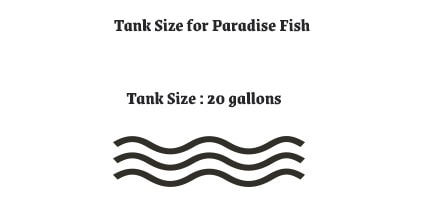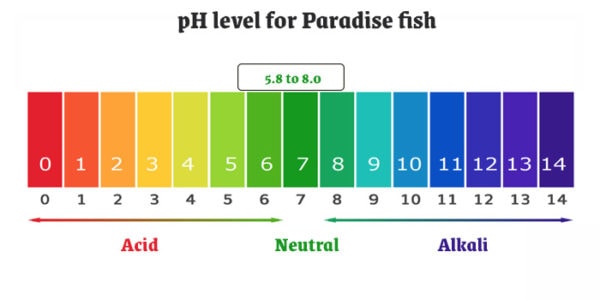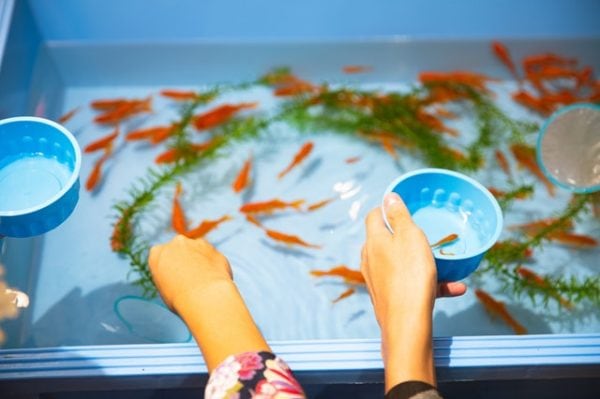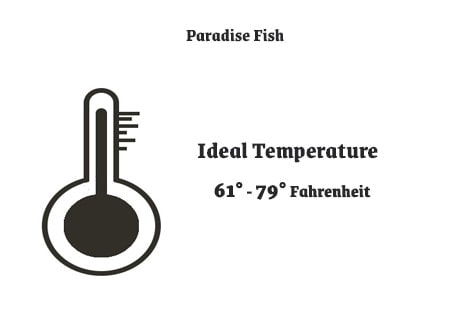The paradise fish (Macropodus opercularis) is a species of gourami found in most types of fresh water in East Asia, ranging from the Korean Peninsula to northern Vietnam. Paradise gouramis were one of the first ornamental fish available to western aquarium keepers and enthusiasts, having been imported in 1869 to France by the French aquarium fish importer Pierre Carbonnier in Paris.
The paradise fish is said to be one of the more aggressive members of its family. They are more aggressive than the three-spot gourami, yet less pugnacious than the less commonly kept combtail. Unfortunately, due to their reputation of being aggressive, their popularity has dropped in the last few years in favour of more peaceful gouramis.
They are a type of Labyrinth fish, which means they develop a lung-like organ that allows them to take oxygen from the surface of the water. It is essential to note that they are not born with this organ, so sufficient oxygenation of your tank water needs to be ensured.
| Information Chart | Paradise Fish |
| Scientific Name: | Macropodus opercularis |
| Family: | Osphronemidae |
| Care Level: | Easy |
| Temperament: | Aggressive |
| Colour: | Red and Blue stripes |
| Lifespan: | 6 to 8 years |
| Size: | 2 to 4 inches |
| Diet: | Omnivore |
| Minimum Tank Size: | 20 gallons |
| Temperature: | 61 to 79 F (or 10-27 C) |
| Water Conditions: | pH of 5.8 to 8.0 |
| Water Hardness: | 5.8-8 |
| Tank Mate Compatibility: | Large, peaceful fish |
Table of Contents
Paradise Fish Appearance
These fish are a colourful choice, they have vivid red and blue stripes that run across their body. The fins don’t tend to have this design, they are generally one colour. The caudal fin is generally orange. Some may have small black/blue spots scattered across the body.
During mating, their colours tend to intensify. The quality of their environment can have an influence their colour. This can happen when they are in a middle of a fight too, but for a shorter amount of time. The blues across their body gets darker, they’ll extend their fins and open up their operculum (the flap that covers the gills) to look threatening.
Most of the ones that have a unique pattern or tail forms are hybrids of a few species of paradise fish. They also hybridize with other gouramis and some betta species.
Types of Paradise Fish
Normal Paradise Fish
M. opercularis naturally have a greenish-blue body with red stripes on their body (the reverse is usually line bred.) Their head is typically lightly patterned with black lines and a black dot on their gill plate. Their tail doesn’t have the webbing in the middle and naturally has a “U” shape.
Blue Paradise Fish
Although not technically a type, some people have bred M opercularis to be bluer and less patterned than their naturally-coloured counterparts.
Albino Paradise Fish
Also, usually a colour mutation for M. opercularis, they can have varying degrees of blue and red within the fins, but the body colour is white and their eyes are red.
Chinese Paradise Fish
A different – but related – species (M. ocellatus) is often sold as the “round tail” or “Chinese” paradise fish. They don’t usually come in colour morphs and are a bit pickier with food.
Black Paradise Fish
It is a different, but related, species that goes by “black” or “spike tail” paradise fish (M. spechti.) They’re much more challenging to find and usually need to be specially ordered. Much like the Chinese paradise fish, they’re a bit pickier with food and don’t usually come in colour morphs.
The lifespan of Paradise Fish
The average paradise fish lifespan is around 6 to 8 years. Assuming that you’re providing them with good care and keeping them in a stress-free environment where they don’t feel the need to fight.
There have been some reported instances where paradise gouramis have lived to be over ten years old. However, these are very uncommon instances that you shouldn’t expect, even with the best possible care.
Natural Habitat and Origin
The fish originates from South-East Asia. It’s natural habitat includes small waters, drains, and paddy fields. Although, these days they are bred outside of their natural habitat as well.
Fish areal stretches from Vietnam to Korea, it lives in bogs, paddy fields and shallow lakes coastline. The species, especially those from South areas of its habitat, are well adapted to living in cold water up to +15 °C; they are not demanding in terms of food and water quality.
The fish eats everything it can swallow but prefers protein food: insects’ larvae, worms, small fishes, and various spineless species.
The paradise fish prefer lowland habitats with warm, slow-moving, stagnant water conditions. They’re found in blackwater rivers, streams, irrigation canals, oxbow lakes, artificial reservoirs, and rice paddies. However, this species has also been found at higher altitudes, with fresh, cold, fast-flowing streams, though I don’t recommend attempting to create the latter environment at home.
Paradise Fish Care & Tank Set-Up
Paradise Fish Tank Size and Specifications
Optimum Tank Size for Paradise Fish

The recommended tank size for Paradise Fish is around 20 gallons. This will give them enough space to feel comfortable and also allow you to include the necessary additions and decorations (more on that later).
If you want to keep a few of them together you’ll need to add at least ten gallons for starters. Due to their potential for aggression toward their species, more room is always better. Additional space will give these fish more places to call their own without the risk of them getting territorial.
Water Parameters for Paradise Fish

Paradise gourami is hardy and can handle a generous range of water parameters. This is one of the parts of paradise fish care that we would consider “easy” and something that anyone can handle no matter what their experience level is.
Use a heater to maintain a temperature between 68-82°F. pH can be slightly acidic or alkaline (6-8), but extremes can’t be reached. Hardness should be 5-30 dH.
You don’t need any special equipment, just a filter and a heater. Some people add air pumps to their tanks, but this isn’t important because these gouramis aren’t used to strong currents and get some oxygen from the air at the surface.
Paradise Fish Tank Landscape

When it comes to setting up their habitat, you’ll want to reference their natural environment as much as possible. Paradise fish come from shallow freshwater that has a lot of vegetation, so plants are going to be a great place to start.
Any of the classic plants like hornwort, java moss, and even dwarf hairgrass can all work with these fish. They’ll interact with these plants and use them for shelter and comfort.
This goes a long way in making sure they’re free of stress and feel safe. Frequent periods of stress can be bad for the health of a fish, so adding some plants is not optional.
Like most labyrinth fish they need a tight-fitting lid for humidity as well. Since they breathe air but live-in water, the air they breathe needs to be humid to prevent damaging their labyrinth organ. Dry air can lead to something similar to respiratory infection in humans. Unlike most other air-breathing fish, the air doesn’t need to be warm to prevent damage and there’s evidence that paradise fish could benefit from a cool period during the winter months.
You’ll want to go with a soft substrate as well. While paradise fish don’t spend much time at the bottom of the tank, it’s yet another way to help replicate their environment in the wild.
Additional hiding spots are not necessary items to include for these fish, but you might end up adding some for any tank mates they might have.
Keep the tank clean and keep nitrate levels as close to zero as possible by performing 25% water changes every couple of weeks.
Since Paradise gourami spend most of their time near the surface, they generally do not need any specific lighting, as they will get a lot of natural light. Usually, the bulb that comes housed in the lid is sufficient or you could purchase a small LED light to hang over the tank.
Feeding Paradise Fish
Best Diet for Paradise Fish
In the wild, paradise fish will eat a wide variety of foods depending on where they live. They’re omnivores which means they aren’t picky!
In a tank, you’ll want to maintain balance in their diet by giving them a mix of different foods. Flakes and pellet food make for a great base of reliable nutrition that is affordable and simple to feed them.
However, it’s important not to forget about the value of protein in their diet. In the wild they’ll get a lot of protein from different kinds of insects, so incorporating that into their feeding schedule is a must.
Bloodworms, brine shrimp, larvae, and white worms are all great choices. Try to feed them live food when possible, to maximize the nutritional density of their foods and provide them with enrichment.
How often should you feed Paradise Fish?
Paradise fish should typically be fed once or twice a day as per your schedule. We recommend twice if possible because that will reduce stress (it’s fun for them to eat) and be better on their digestive system.
Paradise Fish Behaviour and Temperament

Behaviour can vary between individuals, but they’re relatively social and active animals. Unlike most other gourami, the paradise variety is particularly aggressive.
Most of this aggression is focused on individuals of the same species, but sometimes other fish get caught in the crossfire.
Fighting can lead to physical damage and health problems, in some cases it could be fatal.
Watch out for mating behaviours as these usually trigger fighting. Males are the most aggressive and will compete for females, so males should be kept separately. Territory can be an issue as well, but this will just be a case of chasing intruders away.
Paradise Fish Tank Mates
These fish don’t get along well with others, particularly if they’re a similar size or smaller.
They need to be the dominant species in the tank, if you add other aggressive fish then they will compete for control. This will either lead to fights and physical damage, or your paradise fish will hide and live in stress.
As a result, your options for tankmates are limited. Some people choose to keep a species tank to avoid risking incompatible tank mates, but there are a few options available for community aquariums.
Ideal Paradise Fish Tank Mates
The perfect paradise fish tank mates are fish that are larger than them, but not aggressive. This is because they’re too big for the little paradise fish to cause them any harm and they won’t start fights either.
Some paradise fish tank mates that aquarists have had success with are:
- Bala sharks
- Bristlenose plecos
- Synodontis catfish
- Gian danios
While a lot of owners tend to keep these fish alone due to this potential for aggression, if you have your heart set on a community tank it’s possible. Simply stick to the guidelines that we’ve listed in this section and you should be fine.
Bad Tank Mates for Paradise Fish
Fish that are their size or smaller are not compatible tank mates. Your paradise fish will likely pick on, injure, and potentially kill them.
Any aggressive fish are tank mates to avoid as well. Two dominant aggressive temperaments in the same tank will always lead to conflict and fights at some point, which is a major issue.
Breeding Paradise Fish
This species can be bred in captivity very easily.
Like bettas and other gourami species, paradise fish are bubble nest builders. A male blows bubbles that float up to the surface; a big enough collection forms a nest. Each bubble is coated in saliva to make them more durable.
A good nest attracts females because they are a safe place to lay eggs. You can tell when a female is ready to mate because it’ll look plump as they fill with eggs.
You will see the male try to court the females, which can lead to some interesting displays. The male will wrap himself around the female several times, similarly to when Betta fish breed.
During the process, the female will lay eggs, which normally float up to the nest. The pair will repeat this until all the eggs are laid, this can take anywhere from ten minutes to a few hours.
Once the eggs are all safe in the bubble nest, the fry could take anywhere from 30-90 hours to hatch.
After the eggs have been laid, you should remove the male from the tank. They will become very protective over the nest which could mean they will attack the females. They are prone to eating the fry once they have hatched too.
Alternatively, you can use a separate tank of around 10 gallons to raise the fry.
If your fish are stressed, then they won’t mate. To eliminate the stress you need to do the things that we’ve already mentioned in other sections; keeping the tank clean, feeding the fish a healthy diet and making sure they don’t have any diseases.
Paradise Fish Breeding Difficulty – Easy
Paradise Fish Sexual Dimorphism :
The males are noticeably larger than females; they have larger fins, brighter and more saturated colouring.
Paradise Fish Common Diseases and their Treatment
Paradise Gourami’s are very hardy so diseases are usually not a problem in a well-maintained aquarium. Some diseases they are prone to are bacterial infections, constipation and Hole in the Head if good water quality, nutrition, and maintenance are not provided. With any additions to a tank such as new fish, plants, substrates, and decorations there is a risk of introducing disease. It’s advisable to properly clean or quarantine anything that you want to add to an established tank before introduction, so as not to upset the balance.
These fish are very resilient but knowing the signs of illness, and catching and treating them early makes a huge difference. An outbreak of disease can often be limited to just one or a few fishes if you deal with it at an early stage. The best way to proactively prevent disease is to give your fish the proper environment and a well-balanced diet. The closer to their natural habitat the less stress the fish will have, making them healthier and happy. A stressed fish will be more likely to acquire the disease.
Facts about Paradise Fish
- Macropodus opercularis is also termed as the “true” paradise fish, other related fish share the name. The brown spike-tailed paradise fish, for example, is smaller and much more elegant.
- There are several domesticated strains of paradise fish, including powder-blue varieties, albino fish and individuals with more intense colouration.
- Wild-type paradise fish have colours and patterns similar to dwarf gourami and giant gourami— two distantly related species.
- Male paradise fish tend to fight violently with other anabantid species. Never keep a paradise fish with a betta, gourami or climbing perch. They may display aggression towards long-finned species like the angelfish.
- Paradise fish lay their eggs in bubble nests. The male Paradise fish blows a web of saliva-coated bubbles underneath a broad-leafed plant at the surface of the water. Later, mates with the female and deposits the eggs in the nest.
- Paradise fish tend to change their colours depending on the mood, temperature, water quality and breeding interest.
Are Paradise Fishes Right For You?
Usually, small fish can be added to most community aquariums because they’re not aggressive to tank mates, but paradise fish don’t fit this trend.
If you want to keep paradise fish then your tank needs to be species-specific or a community of large, peaceful fish. Any smaller fish will be attacked.
Other than this, setting up a tank with these fish is fairly straightforward. They’re not fussy eaters and they only need some plants to keep them happy.
They will flourish when kept in a healthy environment, showing off their colours and social behaviours.
Yes, not only can they live alone, it is advised to keep them alone or as a pair (1 male, 1 female).
They can tolerate more than other species, but you should still have a filter on your tank to maintain good quality water.
If the ambient room temperature keeps the tank around or above 20°C/68°F then you don’t need a heater, but you should have a thermometer.
Males tend to be brighter and slightly larger than females. A female will only appear larger when she is carrying eggs.
You should always move the male from the tank as soon as the eggs have hatched, alternatively, you can move the fry to another tank as soon as they start to hatch so long as their water conditions remain the same.
Conclusion
Paradise fish care is an interesting process. A lot of the aspects of keeping these fish happy and healthy are pretty easy. They’re hardy and relatively low-maintenance when it comes to water and tank conditions.
But their aggression is a whole other story.
This is what most of your time and planning will be devoted to if you decide to own one of these fish. Paradise gouramis are quite feisty and have no fear when it comes to initiating conflict with other fish.
Despite all that, we think they’re still a great freshwater fish to buy. They’re fun to watch and look stunning!
If you’re on the fence or are concerned about potential issues with aggression, we recommend that you consider a single-fish tank. That will give you peace of mind and allow you to enjoy their natural beauty.
If you have any miscellaneous questions about these fish or have stories/experiences to share, get in touch with us! Any additional information that can help make this guide better is always welcome.
